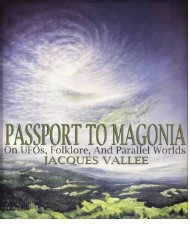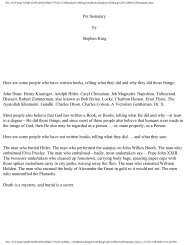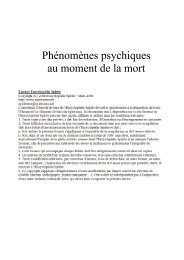extraordinary%20encounters
extraordinary%20encounters
extraordinary%20encounters
You also want an ePaper? Increase the reach of your titles
YUMPU automatically turns print PDFs into web optimized ePapers that Google loves.
means, ranging from naïve New Age nuttiness<br />
to expansions and willed changes of awareness<br />
involving techniques handed down within the<br />
old traditions, but developed and applied in a<br />
modern way” (Stewart, 1995). New Age<br />
fairies are a gentler lot than their harsh counterparts<br />
in tradition. Fairies are now incorporated<br />
into such concerns as healing, gardening,<br />
Earth awareness, ritual magic, and<br />
personal transformation—matters far removed<br />
from the often ill-tempered, impatient,<br />
anthrophobic concerns of traditional<br />
fairies.<br />
See Also: Chaneques; Close encounters of the third<br />
kind; Cottingley fairies; Fairy captures; Magonia;<br />
White’s little people<br />
Further Reading<br />
Barry, John, 1938. “Fairies in Eire.” The Living Age<br />
355 (November): 265–266.<br />
Bord, Janet, 1997. Fairies: Real Encounters with Little<br />
People. New York: Carroll and Graf Publishers.<br />
Briggs, Katharine, 1976. An Encyclopedia of Fairies:<br />
Hobgoblins, Brownies, Bogies, and Other Supernat -<br />
ural Creatures. New York: Pantheon Books.<br />
Davis, Isabel L., 1970. Review of Vallee’s Passport to<br />
Magonia. UFO Investigator (June): 3.<br />
Evans, Alex, 1978. “Encounters with Little Men.”<br />
Fate 31, 11 (November): 83–86.<br />
Evans-Wentz, W. Y., 1966. The Fairy-Faith in Celtic<br />
Countries. New York: University Books.<br />
Galde, Phyllis, 1993. “I See by the Papers: More<br />
Fairies Seen.” Fate 46, 4 (April): 14–15.<br />
Jones, T. Gwynn, 1979. Welsh Folklore and Folk-Cus -<br />
tom. Totowa, NJ: Rowman and Littlefield.<br />
Keightley, Thomas, 1878. The Fairy Mythology. London:<br />
G. Bell.<br />
MacManus, D. A., 1959. The Middle Kingdom: The<br />
Faerie World of Ireland. London: Max Parrish.<br />
Marwick, Ernest W., 1975. The Folklore of Orkney<br />
and Shetland. London: B. T. Batsford.<br />
Narvaez, Peter, ed., 1997. The Good People: New<br />
Fairylore Essays. Lexington: University Press of<br />
Kentucky.<br />
Rojcewicz, Peter M., 1984. The Boundaries of Ortho -<br />
doxy: A Folkloric Look at the UFO Phenomenon.<br />
Ph.D. dissertation, University of Pennsylvania.<br />
Sanderson, St ew a rt, ed., 1976. The Se c ret Common-<br />
Wealth and A Sh o rt Treatise of Charms and Spels by<br />
Ro b e rt Kirk . To t owa, NJ: Rowman and Littlefie l d .<br />
Sheaffer, Robert, 1981. The UFO Verdict: Examining<br />
the Evidence. Buffalo, NY: Prometheus Books.<br />
St ew a rt, R. J., 1995. The Living Wo rld of Fa e ry.<br />
Gl a s t o n b u ry, Somerset, England: Gothic Im a g e<br />
Pu b l i c a t i o n s .<br />
Fairy captures 103<br />
Traum, Artie, 1972. “Rollin’ and Tumblin’: The<br />
Cambridge Festival.” Crawdaddy (November):<br />
20–22.<br />
Vallee, Jacques, 1969. Pa s s p o rt to Magonia: From Fo l k -<br />
l o re to Flying Sa u c e r s . Chicago: He n ry Re g n e ry.<br />
Wilkins, Harold T., 1952. “Pixie-Haunted Moor.”<br />
Fate 5, 5 (July/August): 110–116.<br />
Fairy captures<br />
In 1907, Lady Archibald Campbell, a collector<br />
of traditional lore, interviewed a blind<br />
man and his wife who lived in conditions of<br />
great poverty in an Irish glen. The man told<br />
her, in all apparent seriousness, that once he<br />
had captured a small being he called a leprechaun.<br />
It was two feet tall, with dark but<br />
clear skin and red hair. He was dressed in a<br />
red cap, green clothes, and boots.<br />
“I gripped him close in my arms and took<br />
him home,” the old man related. “I called to<br />
the woman [his wife] to look at what I had<br />
got. ‘What doll is it that you have there?’ she<br />
cried. ‘A living one,’ I said, and put it on the<br />
dresser. We feared to lose it; we kept the door<br />
locked. It talked and muttered to itself queer<br />
words. . . . It might have been near on a fortnight<br />
since we had the fairy, when I said to<br />
the woman, ‘Sure, if we show it in the great<br />
city we will be made up [rich]. So we put it in<br />
a cage. At night we would leave the cage door<br />
open, and we would hear it stirring through<br />
the house. . . . We fed it on bread and rice and<br />
milk out of a cup at the end of a spoon.”<br />
At last the little being escaped, and after<br />
that the family’s fortunes, never much to<br />
begin with, declined even further. The man<br />
lost his sight, and the couple sank ever deeper<br />
into poverty and despair.<br />
A happier story recounts not so much the<br />
capture of a fairy as the domestication of one.<br />
Lady Gregory and W. B. Yeats heard it from<br />
an old couple, the Kellehers, who lived in the<br />
Wickland Mountains of Ireland. The Kellehers<br />
said the events had taken place years before,<br />
when they were newly married.<br />
One winter day, Mr. Kelleher encountered<br />
a fairy and, in some unspecified fashion, got<br />
him to stay in the house for the next week or





